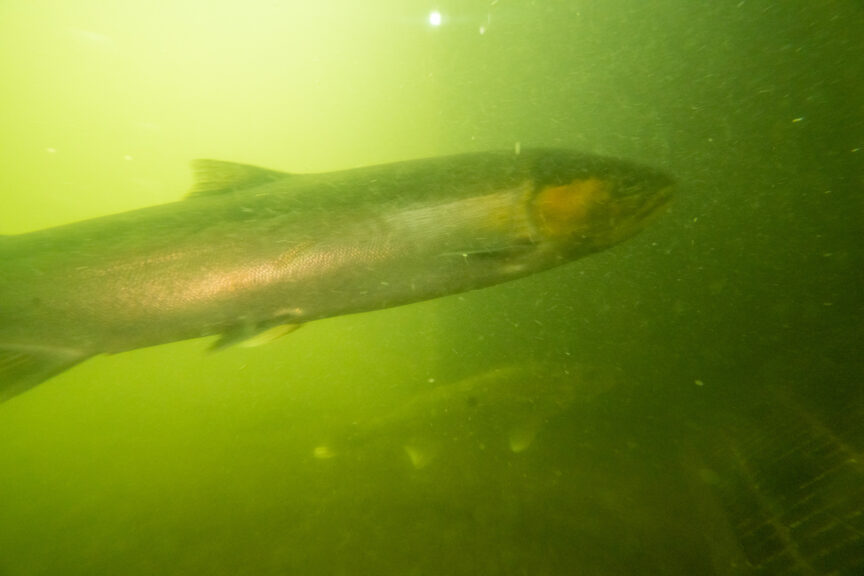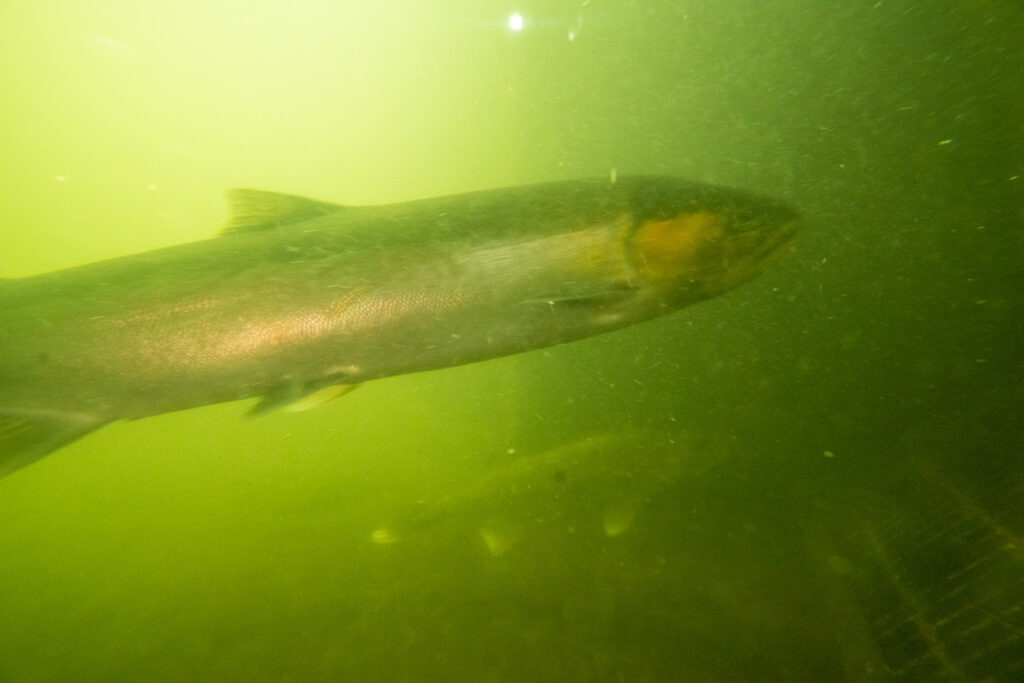
Many migrating summer steelhead overshoot their spawning streams, passing dams multiple times and increasing mortality rates, trying to find cold water refuge
Part One
After leaving the Pacific Ocean, adult summer steelhead returning to the Columbia Basin spend nearly a year maturing in freshwater before spawning the following spring. During that time, these fish display complex migratory patterns. Some move directly into tributaries and others overwinter in the mainstem Columbia or Snake Rivers. A surprising percentage of steelhead move up and down the system, passing through the large mainstem dams multiple times in the process.
During the warmer parts of the year, mainstem, and some tributary, water temperatures often become hostile to summer steelhead. As such, the fish must seek out coldwater refuges. For steelhead in the mid-Columbia, these coldwater areas lie far upstream, within the upper end of the anadromous reaches of the Columbia and Snake watershed that aren’t completely blocked by unpassable dams. To access these areas, many steelhead travel past, or “overshoot,” their natal waters and ascend multiple dams to reach suitable holding water. Having already expended significant energy to ascend the hydro system, these steelhead eventually need to undertake a perilous journey downstream, or “fallback,” to reach their spawning streams. But many of these fish never make it back. They often end up straying to other tributaries or incurring high mortality along the way as they pass through the hydro system again.
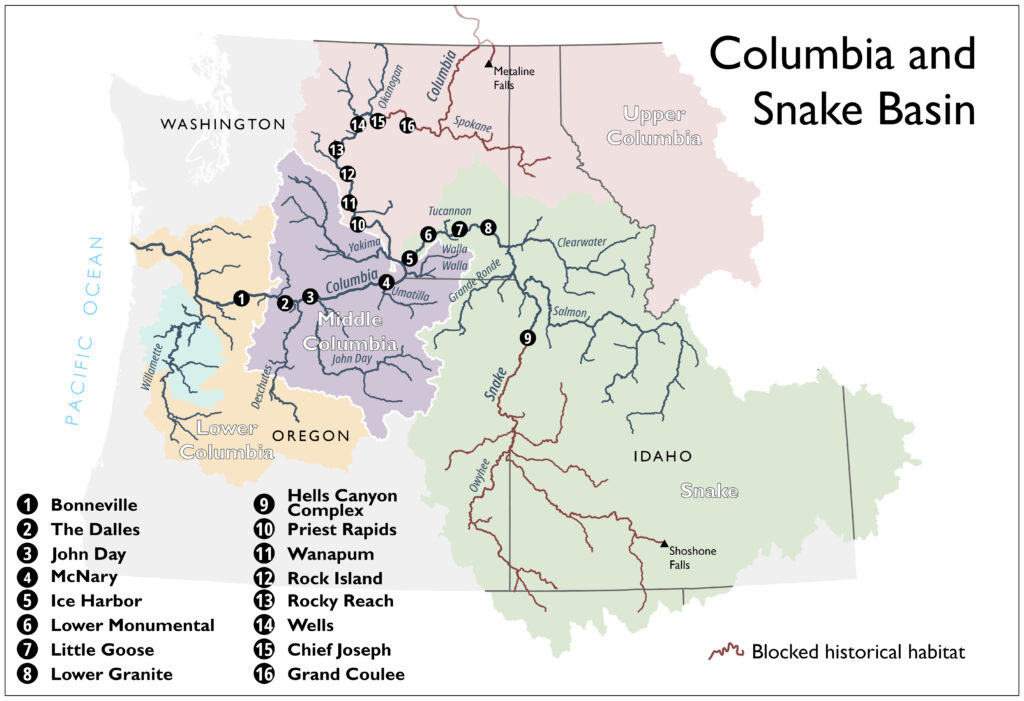
Above: The Columbia and Snake Basin hydropower systems. Image: Matt Mayfield.
While it has been recognized that both salmon (especially summer Chinook) and steelhead overshoot their spawning streams, passing additional dams in the process, these overshoot fish do not fit well within the current hydro system management regime. This infrastructure is designed to produce electricity, control flooding, and facilitate barge transport. Mitigating the system’s negative impacts on anadromous fish is based on the goals of passing small juveniles downstream during their migration to the Pacific and allowing returning adults back upstream, directly to their home spawning streams. Fish counting, downstream fish passage facilities, and spill regimes have not been designed or operated with adult fish falling back downriver in mind.
Not properly accounted for overshoot steelhead can have serious ramifications for fisheries management. By including overshoot fish from the mid-Columbia River, the counts of steelhead heading into the upper basin are artificially inflated, biasing data that is crucial for management of ESA-listed stocks. While managers have attempted to correct for overshoot in their population estimates, the scale of overshoot and fallback steelhead in the basin had not been properly studied or fully understood until two recent studies set out to provide more insight.
Daylighting the Problem: Two Recent Studies Track Overshoot
Over the last five years, a pair of studies have used passive integrated transponder (PIT) tag data to get a handle on what is going on with overshoot and fallback steelhead throughout the Columbia Basin. The first study by Richins and Skalski in 2018 used PIT tag data from specific tributaries to understand watershed specific patterns, while the Murdoch et al. study in 2022 used adult steelhead PIT tagged at Priest Rapids Dam to assess the abundance and migration success of overshoot steelhead in the upper Columbia River.
Let’s break down what they found.
While overshooting is believed to be relatively rare in free-flowing rivers, it was pervasive throughout the Columbia basin. Richins and Skalski found that overshoot rates exceeded 50% in at least one year for eight of 23 hatchery and wild populations they evaluated, with the Umatilla, Walla Walla, John Day and Tucannon rivers having exceptionally high rates.
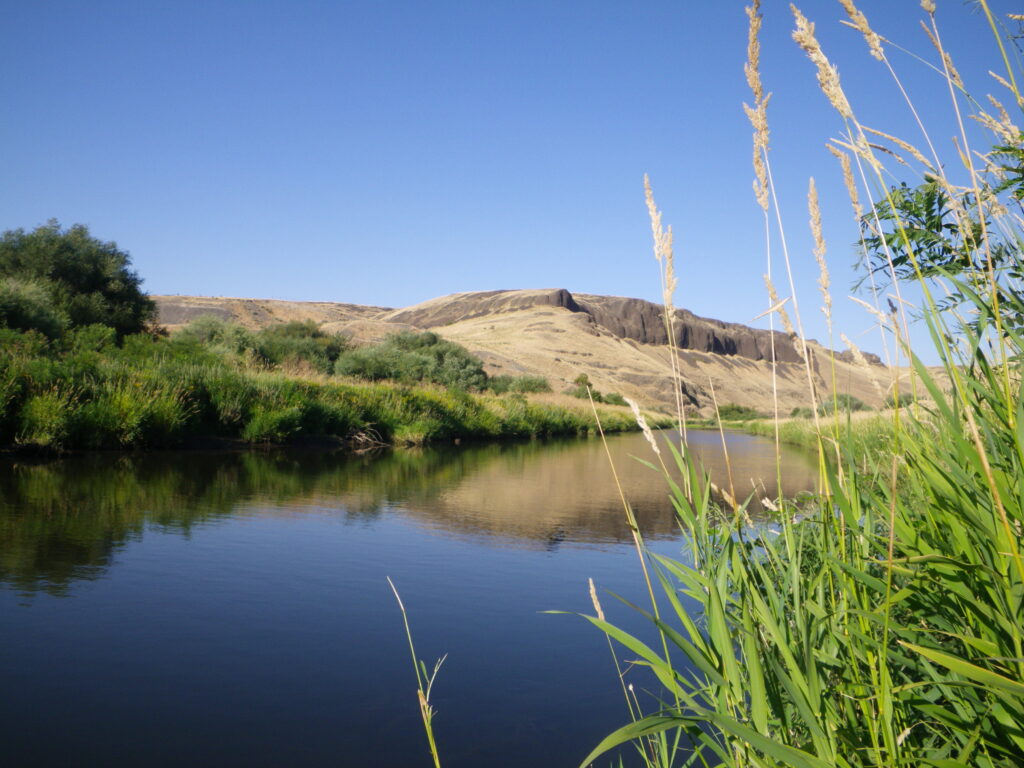
Similarly, Murdoch et al. found that the average abundance of overshoot wild steelhead at Priest Rapids dam was 1,856 fish, which accounted for 45% of the average overall adjusted Priest Rapids wild steelhead count. Of the known wild overshoot fish tagged at Priest Rapids Dam, 53% were from the Snake River Distinct Population Segment (DPS) and 47% were from the mid-Columbia. Yakima River wild steelhead had the highest overshot rate into the upper Columbia River, accounting for 53% of the mid-Columbia steelhead passing Priest Rapids Dam.
Overshooting didn’t just occur at Priest Rapids, either. Wells Dam had the second highest overshoot rate in the upper Columbia River, with 20% of the wild steelhead passing Wells Dam being overshoot fish. In the Snake River things appear to be even worse, with five times more known overshoot steelhead from the mid-Columbia DPS passing Ice Harbor Dam than Priest Rapids Dam, complicating proper accounting of Upper Columbia and Snake River steelhead passing the dams.
So why are overshoot rates so high in the Columbia River system, when they are relatively rare in free-flowing rivers? Richins and Skalski showed that steelhead overshoot rates in the Columbia Basin were strongly correlated with water temperatures near natal streams. For example, the probability that a steelhead moved directly into its natal stream went from over 90% to less than 25% as water temperatures increased from 50°F to 68°F (10°C to 20°C). This finding strongly supports the idea that these steelhead were seeking out coldwater refuges. Such overshoot rates, and the need for steelhead to find these safe places to hold, will only get worse with climate change.
The location of fish ladders at the dams downstream of spawning streams is also an important factor in whether steelhead overshoot their natal streams or not. Adult steelhead using ladders on the opposite shore from their natal streams overshot their home waters 18% more often than those using ladders on the same shore as their natal streams. The largest impact was for populations migrating to tributaries shorter distances upstream of mainstem dams. This result suggests that the wide reservoir channels and/or high attraction flow on the opposite shoreline from natal tributaries are interfering with the ability of steelhead to detect the unique chemical signature of their natal streams.
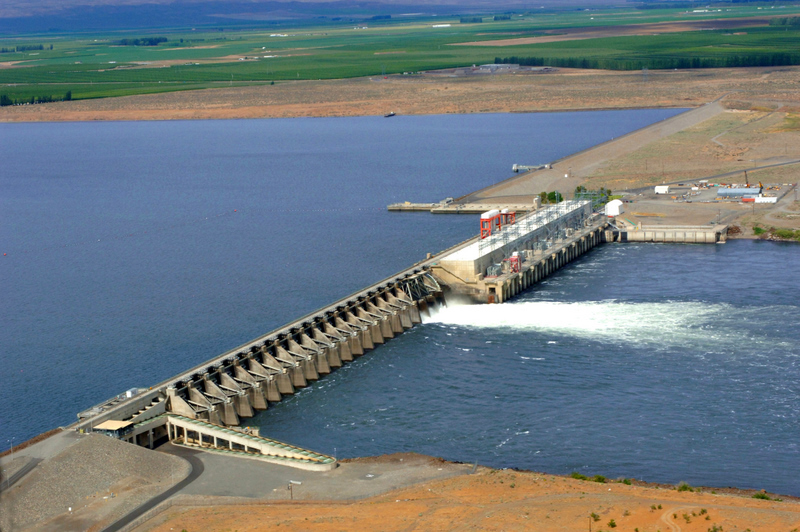
Image: Washington Department of Ecology.
The study by Richins and Skalski also found a hatchery effect associated with overshoot rates. In particular, segregated hatchery stocks had a 15% higher overshoot rate than either wild or integrated stocks. Outplanted fish (i.e. juveniles that are trucked away from a hatchery to be directly released into a stream elsewhere) showed a staggering 65% higher overshoot rate than wild fish. This phenomenon was attributed to sequential imprinting being impaired when hatchery fish are reared upstream of their release location. (Migratory fish, like steelhead, imprint on their home waters over time as they migrate downstream.)
We’ll be back next week with Part Two (READ PART TWO HERE), looking at the impacts to fish traveling downstream through the hydro system, and discussion of possible management changes to help improve steelhead survival.
Learn more about Trout Unlimited’s work to restore a free-flowing lower Snake River and replace the services they provide at www.tu.org/lowersnake/


